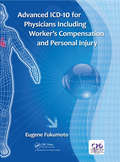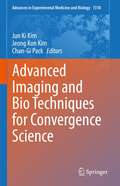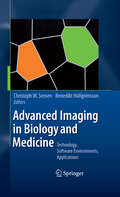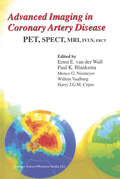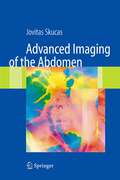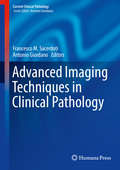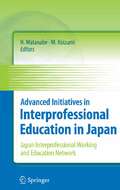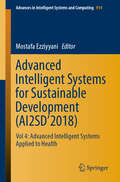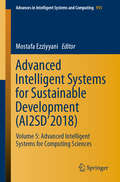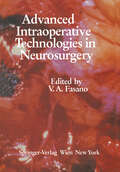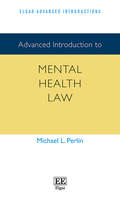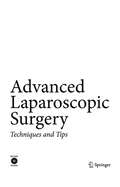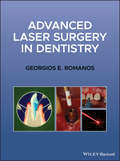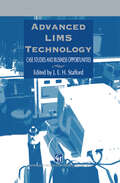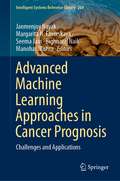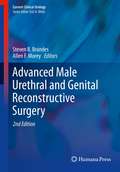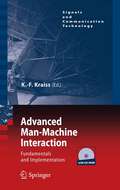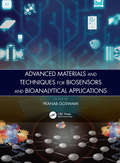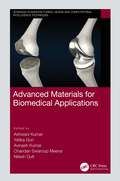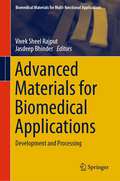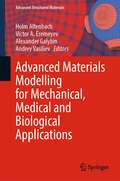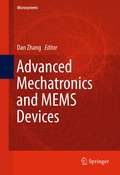- Table View
- List View
Advanced ICD-10 for Physicians Including Worker’s Compensation and Personal Injury
by Eugene FukumotoICD-10 is the 10th revision of the International Statistical Classification of Diseases and Related Health Problems (ICD), a medical classification list by the World Health Organization. It contains codes for diseases, signs and symptoms, abnormal findings, complaints, social circumstances, and external causes of injury of diseases. The code set allows more than 14,000 different codes and permits the tracking of many new diagnoses. The U.S. has used ICD-10-CM (Clinical Modification) since October, 2015. This national variant of ICD-10 was provided by the Centers for Medicare and Medicaid Services (CMS) and the National Center for Health Statistics, and the use of ICD-10-CM codes are now mandated for all inpatient medical reporting requirements. This book is for physicians, practice managers and all others who need learn ICD-10. It’s designed for the clinician to learn how to put their diagnosis into a code and not rely on staff or computer software programs to decide it form them. ICD-10 is a complex system of coding and Medicare and third party insurers have been lenient giving providers a year to get used to the coding system. As a result, physicians and their staff have become very complacent regarding proper coding. However, Medicare and third party insurers will soon begin to deny claims which are not coded correctly, which in turn will cost physician groups time and money. This book focuses on Worker’s Compensation and Personal Injury, a very large segment of the healthcare industry and is a new area to ICD-10. The diagnosis coding for injuries is much different than for Medicare or group insurance and unless the physicians and their staff learn how to use it properly, they risk losing income for themselves and worse, they risk losing the case for the patient.
Advanced Imaging and Bio Techniques for Convergence Science (Advances in Experimental Medicine and Biology #1310)
by Jun Ki Kim Jeong Kon Kim Chan-Gi PackThis book is a wide-ranging guide to advanced imaging techniques and related methods with important applications in translational research or convergence science as progress is made toward a new era in integrative healthcare. Conventional and advanced microscopic imaging techniques, including both non-fluorescent (i.e., label-free) and fluorescent methods, have to date provided researchers with specific and quantitative information about molecules, cells, and tissues. Now, however, the different imaging techniques can be correlated with each other and multimodal methods developed to simultaneously obtain diverse and complementary information. In addition, the latest advanced imaging techniques can be integrated with non-imaging techniques such as mass spectroscopic methods, genome editing, organic/inorganic probe synthesis, nanomedicine, and drug discovery. The book will be of high value for researchers in the biological and biomedical sciences or convergence science who need to use these multidisciplinary and integrated techniques or are involved in developing new analytical methods focused on convergence science.
Advanced Imaging in Biology and Medicine: Technology, Software Environments, Applications
by Ch. W. Sensen Benedikt HallgrimssonA picture says more than a thousand words. This is something that we all know to be true. Imaging has been important since the early days of medicine and bi- ogy, as seen in the anatomical studies of Leonardo Da Vinci or Andreas Vesalius. More than 100 years ago, the ?rst noninvasive imaging technologies, such as K- rad Roentgen’s X-ray technology,were applied to the medical ?eld—and while still crude—revolutionized medical diagnosis. Today, every patient will be exposed to some kind of advanced imaging technology such as medical resonance imaging, computed tomography or four-dimensional ultrasound during their lifetime. Many diseases, such as brain tumors, are initially diagnosed solely by imaging, and most of the surgical planning relies on the patient imagery. 4D ultrasound is available to expecting parents who wish to create unique early memories of the new baby, and it may soon be used for the morphometric diagnosis of malformations that may one day be treatable—inutero! Light and electron microscopy are unequal brethren, which have contributed to most of our knowledge about the existence and organization of cells, tissues and microorganisms. Every student of biology or medicine is introduced to the fascinating images of the microcosm. New advances have converted these im- ing technologies, which were considered by many to be antiquated, into powerful tools for research in systems biology and related ?elds.
Advanced Imaging in Coronary Artery Disease: PET, SPECT, MRI, IVUS, EBCT (Developments in Cardiovascular Medicine #202)
by Ernst E. Van Der Wall Paul K. Blanksma Menco G. Niemeyer Willem Vaalburg Harry J. G. M. CrijnsIn Advanced Imaging in Coronary Artery Disease, the role of several imaging techniques in diagnosing atherosclerosis, assessment of myocardial ischemia, myocardial viability, and heart failure are broadly discussed. The issues derived from cardiac PET are presented in relation to the conventional techniques, such as echocardiography, SPECT and MRI. In addition, newer imaging techniques such as intracoronary ultrasound, electron beam computed tomography, and Raman spectroscopy are given wide attention. The effects of drug treatment, such as anti-ischemic and lipid-lowering drugs, are also evaluated. This book will assist clinical cardiologists, nuclear medicine physicians, fellows in cardiology and nuclear medicine, radiochemists, basic research fellows, and technicians, in understanding the new advances in clinical cardiac PET.
Advanced Imaging of the Abdomen
by Jovitas SkucasAdvanced Imaging of the Abdomen is invaluable to the practising radiologist, and the more senior radiology resident and fellow, who is looking for a background reference source when discussing a suggested imaging approach with the referring physician. The book includes extensive lists, tables, line drawings and illustrations - ultrasonography, computed tomography, magnetic resonance images, scintigraphy. It bridges the interface between the referring clinician and radiologist when faced with a patient suspected of having a complex or more unusual abdominal condition.
Advanced Imaging Techniques in Clinical Pathology (Current Clinical Pathology)
by Francesco M. Sacerdoti Antonio Giordano Carlo CavaliereThis text provides a comprehensive, state-of-the-art review of the application of image analysis focusing on the techniques which can be used in every biology and medical laboratory to automate procedures of cell analysis and to create statistics very useful for a comprehension of cell growth dynamics and the effects of drugs on them. This textbook will serve as a very useful resource for physicians and researchers dealing with, and interested in, cell analysis. It will provide a concise yet comprehensive summary of the current status of the field that will help guide patient management and stimulate investigative efforts. All chapters are written by experts in their fields and include the most up-to-date scientific and clinical information. Advanced Imaging Techniques in Clinical Pathology will be of great value to clinical pathologists, biologists, biology researchers, and those working in the clinical and biological laboratory arena.
Advanced Initiatives in Interprofessional Education in Japan: Japan Interprofessional Working and Education Network (JIPWEN)
by Hideomi Watanabe Misako KoizumiInterprofessional education (IPE) is becoming a recognized discipline among health care professionals and medical training institutions worldwide. Its significance is especially felt in Japan, where little has been written on the subject although the need is great. Recent initiatives among several institutions have helped to create the Japan Interprofessional Working and Education Network (JIPWEN), comprising ten universities. Through consultation and cooperation with the World Health Organization, other international networks, and local health policy planners, JIPWEN focuses on critical issues and applicable models to assist institutions interested in setting up IPE programs. With contributions from the ten JIPWEN member universities, this book explains in detail the diverse contents of existing IPE programs and provides viable models for the increasing number of institutions aiming to develop their own IPE programs. The chapters that make up the book depict the member institutions' backgrounds, goals, methods, modules, student compositions, facilitation systems, and curricula, providing an invaluable description of IPE initiatives currently under way in Japan.
Advanced Intelligent Systems for Sustainable Development: Vol 4: Advanced Intelligent Systems Applied to Health (Advances in Intelligent Systems and Computing #914)
by Mostafa EzziyyaniThis book gathers papers presented at the International Conference on Advanced Intelligent Systems for Sustainable Development (AI2SD-2018), which was held in Tangiers, Morocco on 12–14 July 2018. Highlighting the latest research and advances in the field of healthcare, it shares essential insights into the health sector, and is intended to stimulate further discussion and promote closer interdisciplinary collaboration among researchers and health professionals.
Advanced Intelligent Systems for Sustainable Development: Volume 5: Advanced Intelligent Systems for Computing Sciences (Advances in Intelligent Systems and Computing #915)
by Mostafa EzziyyaniThis book includes the outcomes of the International Conference on Advanced Intelligent Systems for Sustainable Development (AI2SD-2018), held in Tangier, Morocco on July 12–14, 2018. Presenting the latest research in the field of computing sciences and information technology, it discusses new challenges and provides valuable insights into the field, the goal being to stimulate debate, and to promote closer interaction and interdisciplinary collaboration between researchers and practitioners. Though chiefly intended for researchers and practitioners in advanced information technology management and networking, the book will also be of interest to those engaged in emerging fields such as data science and analytics, big data, internet of things, smart networked systems, artificial intelligence, expert systems and cloud computing.
Advanced Intraoperative Technologies in Neurosurgery
by Victor AldoFasano R. E. Wharen R. Urciuoli A. W. Silberman J. M. Rubin I. L. Richmond A. Renieri R. W. Rand C. R. Neblett D. T. Mason T. Letardi G. Lee E. R. Laws P. J. Kelly R. M. Ikeda A. Harders J. M. Gilsbach V. A. Fasano M. S. B. Edwards G. J. Dohrmann M. C. Chan L. J. Cerullo J. E. Boggan R. E. AndersonSince the introduction of electrosurgery the techniques of surgery on the nervous system have passed through further improvements (bipolar coagulation, microscope), even if the procedure was not substantially modified. Today, laser represents a new "discipline", as it offers a new way of performing all basic maneuvers (dissection, demolition, hemostasis, vessel sutures). Furthermore, laser offers the possibility of a special maneuver, namely reduction of the volume of a tumoral mass through vaporization. Its application is not restricted to traditional neurosurgery but extends also to stereotactic and vascular neurosurgery. Laser surgery has also influenced the anesthesiologic techniques. At the same time new instrumentation has been introduced: CUSA ultrasonic aspiration, echotomography, and Doppler flowmeter. I have had the chance to utilize these new technologies all at a time and have come to the conclusion that we are facing the dawn of a new methodology which has already shown its validity and lack of inconveniences, and whose object is to increase the precision of neurological surgery. The technological development is still going on, and some improvements are to be foreseen. Laser scalpel is splitting the initial laser surgery into NO TOUCH and TOUCH surgery with laser. As new instrumentarium will be developed, a variable and tunable beam will become available. For example, in a few years Free Electron Laser will further add to the progress in this field.
Advanced Introduction to Mental Health Law (Elgar Advanced Introductions series)
by Michael L. PerlinElgar Advanced Introductions are stimulating and thoughtful introductions to major fields in the social sciences, business and law, expertly written by the world’s leading scholars. Designed to be accessible yet rigorous, they offer concise and lucid surveys of the substantive and policy issues associated with discrete subject areas. Written by esteemed legal scholar Michael L. Perlin, this indispensable Advanced Introduction examines the long-standing but ever-dynamic relationship between law and mental health. The author discusses and contextualises how the law, primarily in the United States but also in other countries, treats mental health, intellectual disabilities, and mental incapacity, giving examples of how issues such as the rights of patients, the death penalty and the insanity defense permeate constitutional, civil, and criminal matters, and indeed the general practice of law. Key features include: • unpacks key US Supreme Court decisions to focus on the issues that have been most significant in the development of the field • explains the distortion of this area of law by biased and stereotypical social attitudes including sanism • examines lesser-known cases that illuminate judicial attitudes, helping readers to better understand likely future developments in mental health law. Offering an insightful introduction to this field, the Advanced Introduction to Mental Health Law is an invaluable resource for students and newly qualified lawyers, and will appeal not only to those looking to understand the law in the United States, but how this contributes to the development of the field as a whole.
Advanced Laparoscopic Surgery: Techniques and Tips
by Namir KatkhoudaThis second edition of Advanced Laparoscopic Surgery, Techniques and Tips represents a comprehensive description of the current laparoscopic techniques. It supplies surgeons with all the information necessary to successfully accomplish laparoscopic surgery. It is a hands-on manual that helps the surgeon avoid pitfalls and acquire the necessary laparoscopic skills quickly and efficiently. It is a ready source of practical help when trouble-shooting is necessary. Advanced laparoscopic surgery is an excellent merger of a textbook and atlas for the surgeon who wants to extend and refine his laparoscopic techniques.
Advanced Laser Surgery in Dentistry
by Georgios E. RomanosAdvanced Laser Surgery in Dentistry delivers a state-of-the-art reference for laser technology in the context of a dental practice. The book encompasses oral surgery, periodontology, and implant dentistry, covering the latest research, knowledge, and clinical practices. The author demonstrates the clinical relevance by including many real-world clinical cases that illustrate the application of the discussed techniques. The book includes high-quality, color photographs throughout to support the text and add visual information to the covered topics, which include wound healing, oral surgery, periodontology, implant dentistry, and laser fundamentals and safety considerations. Advanced Laser Surgery in Dentistry provides readers with a step-by-step guide for using lasers in dental practice and discusses likely new directions and possible future treatments in the rapidly advancing field of laser dentistry. Readers will also benefit from a wide variety of subjects, including: A thorough introduction to the fundamentals of lasers, including the beam, the laser cavity, active mediums, lenses, resonators, and delivery systems An exploration of lasers and wound healing, including soft tissue and bone healing, as well as laser-assisted excisions and osteotomies An analysis of lasers in periodontology, including laser-assisted bacteria reduction in the periodontal tissues and the removal of subgingival dental calculus A discussion of lasers in implant dentistry and treatment for peri-implantitis Perfect for oral and maxillofacial surgeons, periodontists, and implant dentists, as well as general dentists, Advanced Laser Surgery in Dentistry will also earn a place in the libraries of dental students and residents seeking to improve their understanding of laser-based oral and dental procedures with a carefully organized reference guide.
Advanced Laser Surgery in Dentistry
by Georgios E. RomanosAdvanced Laser Surgery in Dentistry delivers a state-of-the-art reference for laser technology in the context of a dental practice. The book encompasses oral surgery, periodontology, and implant dentistry, covering the latest research, knowledge, and clinical practices. The author demonstrates the clinical relevance by including many real-world clinical cases that illustrate the application of the discussed techniques. The book includes high-quality, color photographs throughout to support the text and add visual information to the covered topics, which include wound healing, oral surgery, periodontology, implant dentistry, and laser fundamentals and safety considerations. Advanced Laser Surgery in Dentistry provides readers with a step-by-step guide for using lasers in dental practice and discusses likely new directions and possible future treatments in the rapidly advancing field of laser dentistry. Readers will also benefit from a wide variety of subjects, including: A thorough introduction to the fundamentals of lasers, including the beam, the laser cavity, active mediums, lenses, resonators, and delivery systems An exploration of lasers and wound healing, including soft tissue and bone healing, as well as laser-assisted excisions and osteotomies An analysis of lasers in periodontology, including laser-assisted bacteria reduction in the periodontal tissues and the removal of subgingival dental calculus A discussion of lasers in implant dentistry and treatment for peri-implantitis Perfect for oral and maxillofacial surgeons, periodontists, and implant dentists, as well as general dentists, Advanced Laser Surgery in Dentistry will also earn a place in the libraries of dental students and residents seeking to improve their understanding of laser-based oral and dental procedures with a carefully organized reference guide.
Advanced LIMS Technology: Case Studies and Business Opportunities
by J. E. H. StaffordLaboratory Information Managements Systems (LIMS) are either custom-built or off-the-shelf solutions to the problems of controlling the flow of data through laboratories. In this book commercial relevance is ensured by authors from major industrial organizations who demonstrate by example successful application of the technology. This book provides an excellent up-to-date overview of this intensely competitive field.
Advanced Machine Learning Approaches in Cancer Prognosis: Challenges and Applications (Intelligent Systems Reference Library #204)
by Janmenjoy Nayak Margarita N. Favorskaya Seema Jain Bighnaraj Naik Manohar MishraThis book introduces a variety of advanced machine learning approaches covering the areas of neural networks, fuzzy logic, and hybrid intelligent systems for the determination and diagnosis of cancer. Moreover, the tactical solutions of machine learning have proved its vast range of significance and, provided novel solutions in the medical field for the diagnosis of disease. This book also explores the distinct deep learning approaches that are capable of yielding more accurate outcomes for the diagnosis of cancer. In addition to providing an overview of the emerging machine and deep learning approaches, it also enlightens an insight on how to evaluate the efficiency and appropriateness of such techniques and analysis of cancer data used in the cancer diagnosis. Therefore, this book focuses on the recent advancements in the machine learning and deep learning approaches used in the diagnosis of different types of cancer along with their research challenges and future directions for the targeted audience including scientists, experts, Ph.D. students, postdocs, and anyone interested in the subjects discussed.
Advanced Male Urethral and Genital Reconstructive Surgery (Current Clinical Urology)
by Steven B. Brandes Allen F. MoreySince the publication of the first edition of Urethral Reconstructive Surgery, important refinements have been added to the urologic surgical armamentarium. Extensively revised and updated, Advanced Male Urethral and Genital Reconstructive Surgery, Second Edition guides urologists in a practical manner on how to evaluate and manage complex urethral and male genital reconstructive challenges. Chapters have been added on wound healing, synchronous urethral strictures, non-transecting anastomotic urethroplasty (including muscle and vessel sparing), overlapping buccal grafts, male urethral slings, genital skin grafting, Peyronie’s surgery, priapism, pediatric strictures and prosthetics. Such chapters greatly strengthen the overall appeal of the book. The volume closes with a new comprehensive appendix of preferred instruments.With broad contributions by international authorities in reconstructive urologic surgery, Advanced Male Urethral and Genital Reconstructive Surgery, Second Edition is a valuable resource for all urologists, from residents to reconstructive surgeons.
Advanced Man-Machine Interaction: Fundamentals and Implementation (Signals and Communication Technology)
by Karl-Friedrich KraissContemporary man-machine interfaces are increasingly characterized by multimodality, nonintrusiveness, context-sensitivity, adaptivity, and teleoperability. The implementation of such properties relies on novel techniques in felds such as, e.g., computer vision, speech technology, trainable classifiers, robotics, and virtual reality. This book puts special emphasis on technological aspects of advanced interface implementation. Furthermore it focuses on interface design and usability. For readers with a background in engineering and computer science, most chapters offer design guidelines and case studies, as well as a description of the functioning and limitations of the algorithms required for implementation. In addition, complementary code examples in C++ are given where appropriate. As a special feature the book is accompanied by two easy-to-handle software development environments, which offer access to extensive public domain software for computer vision, classification, and virtual reality. These environments also provide real-time access to peripheral components like, e.g., webcams or microphones, enabling hands-on experimentation and testing.
Advanced Materials and Techniques for Biosensors and Bioanalytical Applications
by Pranab GoswamiBioanalytical science and its technological subdomain, biosensors, are ever-evolving subjects, striving for rapid improvement in terms of performance and expanding the target range to meet the vast societal and market demands. The key performance factors for a biosensor that drive the research are selectivity, sensitivity, response time, accuracy, and reproducibility, with additional requirements of its portability and inexpensive nature. These performance factors are largely governed by the materials and techniques being used in these bioanalytical platforms. The selection of materials to meet these requirements is critical, as their interaction or involvement with the biological recognition elements should initiate or improve these performance factors. The technique discussed primarily applies to transducers involved in converting a biochemical signal to optical or electrical signals. Over the years, the emergence of novel materials and techniques has drastically improved the performance of these bioanalytical systems, enabling them to expand their analytical horizon. These advanced materials and techniques are central to modern bioanalytical and biosensor research. Advanced Materials and Techniques for Biosensors and Bioanalytical Applications provides a comprehensive review of the subject, including a knowledge platform for both academics and researchers. Considering biosensors as a central theme to this book, an outline on this subject with background principles has been included, with a scope of extending the utility of the book to coursework in graduate and postgraduate schools. Features: • Basic principles on different classes of biosensors, recent advances and applications • Smart materials for biosensors and other rapid, portable detection devices • Metal nanoparticles and nanocrystals for analytical applications • Carbon-based nanoparticles and quantum dots for sensing applications • Nanozymes as potential catalysts for sensing applications • Bioelectrochemiluminescence and photoelectrochemical-based biosensors • Paper electronics and paper-based biosensors • Microbial biosensors: artificial intelligence, genetic engineering, and synthetic biology • Biofuel cells as a signal transduction platform • FET-based biosensors, including ISFET and BioFET This book serves as a reference for scientific investigators and a textbook for a graduate-level course in biosensors and advanced bioanalytical techniques.
Advanced Materials and Techniques for Biosensors and Bioanalytical Applications
by Pranab GoswamiBioanalytical science and its technological subdomain, biosensors, are ever-evolving subjects, striving for rapid improvement in terms of performance and expanding the target range to meet the vast societal and market demands. The key performance factors for a biosensor that drive the research are selectivity, sensitivity, response time, accuracy, and reproducibility, with additional requirements of its portability and inexpensive nature. These performance factors are largely governed by the materials and techniques being used in these bioanalytical platforms. The selection of materials to meet these requirements is critical, as their interaction or involvement with the biological recognition elements should initiate or improve these performance factors. The technique discussed primarily applies to transducers involved in converting a biochemical signal to optical or electrical signals. Over the years, the emergence of novel materials and techniques has drastically improved the performance of these bioanalytical systems, enabling them to expand their analytical horizon. These advanced materials and techniques are central to modern bioanalytical and biosensor research. Advanced Materials and Techniques for Biosensors and Bioanalytical Applications provides a comprehensive review of the subject, including a knowledge platform for both academics and researchers. Considering biosensors as a central theme to this book, an outline on this subject with background principles has been included, with a scope of extending the utility of the book to coursework in graduate and postgraduate schools. Features: • Basic principles on different classes of biosensors, recent advances and applications • Smart materials for biosensors and other rapid, portable detection devices • Metal nanoparticles and nanocrystals for analytical applications • Carbon-based nanoparticles and quantum dots for sensing applications • Nanozymes as potential catalysts for sensing applications • Bioelectrochemiluminescence and photoelectrochemical-based biosensors • Paper electronics and paper-based biosensors • Microbial biosensors: artificial intelligence, genetic engineering, and synthetic biology • Biofuel cells as a signal transduction platform • FET-based biosensors, including ISFET and BioFET This book serves as a reference for scientific investigators and a textbook for a graduate-level course in biosensors and advanced bioanalytical techniques.
Advanced Materials for Biomedical Applications (Advances in Manufacturing, Design and Computational Intelligence Techniques)
by Ashwani Kumar Yatika Gori Avinash Kumar Chandan Swaroop MeenaThe text discusses synthesis, processing, design, simulation and characterization of biomaterials for biomedical applications. It synergizes exploration related to various properties and functionalities in the biomedical field through extensive theoretical and experimental modeling. It further presents advanced integrated design and nonlinear simulation problems occurring in the biomedical engineering field. It will serve as an ideal reference text for senior undergraduate and graduate students, and academic researchers in fields including biomedical engineering, mechanical engineering, materials science, ergonomics, and human factors. The book Employs a problem-solution approach, where, in each chapter, a specific biomedical engineering problem is raised and its numerical, and experimental solutions are presented. Covers recent developments in biomaterials such as OPMF/KGG bio composites, PEEK-based biomaterials, PF/KGG biocomposites, oil palm mesocarp Fibre/KGG biocomposites, and polymeric resorbable materials for orthopedic, dentistry and shoulder arthroplasty applications. Discusses mechanical performance and corrosive analysis of biomaterials for biomedical applications in detail. Presents advanced integrated design and nonlinear simulation problems occurring in the biomedical engineering field. Presents biodegradable polymers for various biomedical applications over the last decade owing to their non-corrosion in the body, biocompatibility and superior strength in growing state. Synergizes exploration related to the various properties and functionalities in the biomedical field through extensive theoretical and experimental modeling.
Advanced Materials for Biomedical Applications (Advances in Manufacturing, Design and Computational Intelligence Techniques)
by Ashwani Kumar Yatika Gori Avinash Kumar Chandan Swaroop Meena Nitesh DuttThe text discusses synthesis, processing, design, simulation and characterization of biomaterials for biomedical applications. It synergizes exploration related to various properties and functionalities in the biomedical field through extensive theoretical and experimental modeling. It further presents advanced integrated design and nonlinear simulation problems occurring in the biomedical engineering field. It will serve as an ideal reference text for senior undergraduate and graduate students, and academic researchers in fields including biomedical engineering, mechanical engineering, materials science, ergonomics, and human factors. The book Employs a problem-solution approach, where, in each chapter, a specific biomedical engineering problem is raised and its numerical, and experimental solutions are presented. Covers recent developments in biomaterials such as OPMF/KGG bio composites, PEEK-based biomaterials, PF/KGG biocomposites, oil palm mesocarp Fibre/KGG biocomposites, and polymeric resorbable materials for orthopedic, dentistry and shoulder arthroplasty applications. Discusses mechanical performance and corrosive analysis of biomaterials for biomedical applications in detail. Presents advanced integrated design and nonlinear simulation problems occurring in the biomedical engineering field. Presents biodegradable polymers for various biomedical applications over the last decade owing to their non-corrosion in the body, biocompatibility and superior strength in growing state. Synergizes exploration related to the various properties and functionalities in the biomedical field through extensive theoretical and experimental modeling.
Advanced Materials for Biomedical Applications: Development and Processing (Biomedical Materials for Multi-functional Applications)
by Vivek Sheel Rajput Jasdeep BhinderThis book provides an insight into the basic fundamentals of the biomaterials used for the biomedical applications, their development and processing techniques. Advanced materials are significantly utilized for the biomedical applications ranging from dental devices to cancer treatment owing to their higher biocompatibility and better interaction with tissues. This book covers the various topics that include basic biocompatibility phenomena, insight to materials science, class of different advanced materials as a biomaterials, development and processing techniques, design and analysis of the developed advanced materials, investigation of its properties and major applications. Recent information regarding the development techniques and methods for improving the properties of the advanced materials in the field of biomedical applications is highlighted in detail. The textbook offers clear explanation of the text in the chapters with self-explanatory figures and tables. It demonstrates the novel methods, opportunities and ideas for developing biomaterials in the field of biomedical applications. It also includes critical review study of the developed advanced materials for biomedical applications in a new summarized form. The inclusion of the discussions on hybrid polymer-based composites and self-healing composite materials offers a special feature in the textbook. It features a thorough overview of the simulation aspect in the biomedical applications. The book features at least 50% of its references from last three–four years’ work in the field of biomaterials and biomedical. The book content adds to the redundancy in the literature work related to biomedical and biomaterials.This book is a valuable resource for academicians, students and scholars from science and engineering background having interest in biomaterials. It is helpful to the biomedical engineering group especially in countries or location where they don’t have access to the major journals.
Advanced Materials Modelling for Mechanical, Medical and Biological Applications (Advanced Structured Materials #155)
by Holm Altenbach Victor A. Eremeyev Alexander Galybin Andrey VasilievThe book is devoted to the 70th birthday of Prof. Sergey M. Aizikovich, which will celebrated on August 2nd 2021. His scientific interests are related to the following topics: Mechanics of contact interactions, Functionally graded materials, Mechanics of fracture, Integral equations of mathematical physics, Inverse problems of the theory of elasticity, and Applications of elasticity to biological and medical problems of mechanics of materials. The papers, collected in the book, are contributions of authors from 10 countries.
Advanced Mechatronics and MEMS Devices (Microsystems #23)
by Dan ZhangAdvanced Mechatronics and MEMS Devicesdescribes state-of-the-art MEMS devices and introduces the latest technology in electrical and mechanical microsystems. The evolution of design in microfabrication, as well as emerging issues in nanomaterials, micromachining, micromanufacturing and microassembly are all discussed at length in this volume. Advanced Mechatronics also provides a reader with knowledge of MEMS sensors array, MEMS multidimensional accelerometer, artificial skin with imbedded tactile components, as well as other topics in MEMS sensors and transducers. The book also presents a number of topics in advanced robotics and an abundance of applications of MEMS in robotics, like reconfigurable modular snake robots, magnetic MEMS robots for drug delivery and flying robots with adjustable wings, to name a few.
